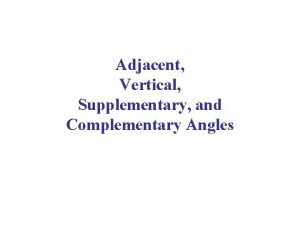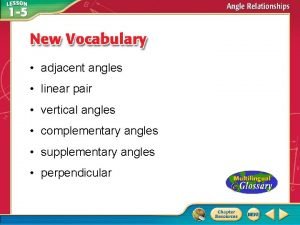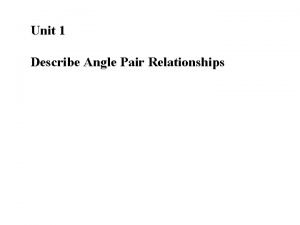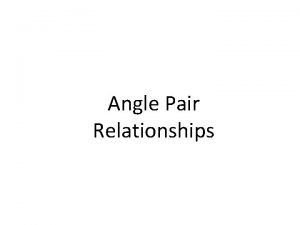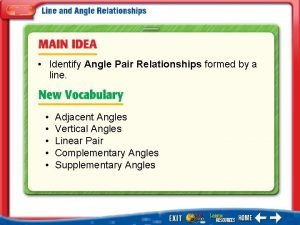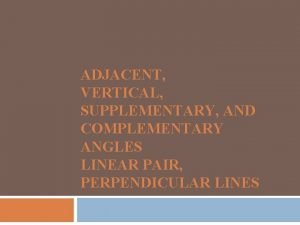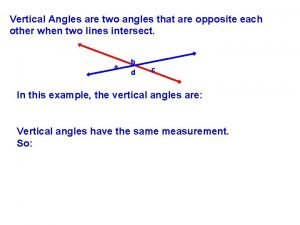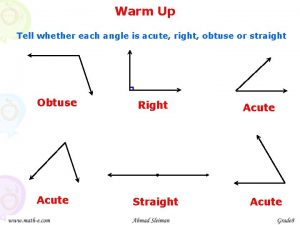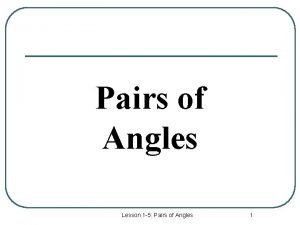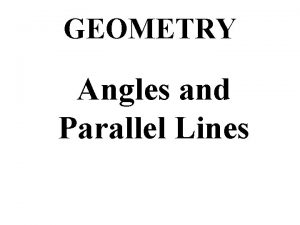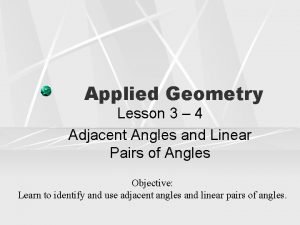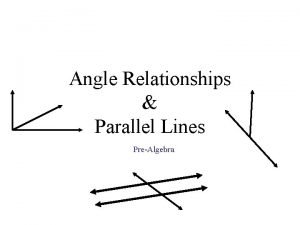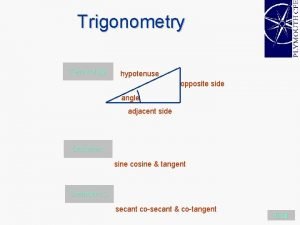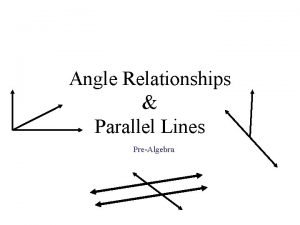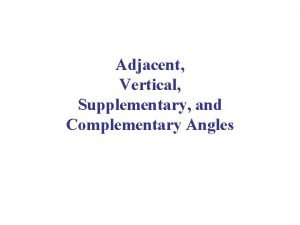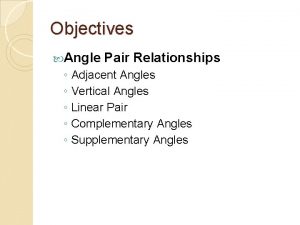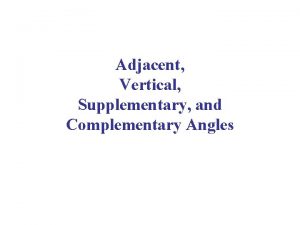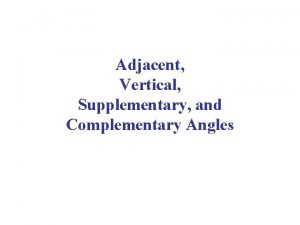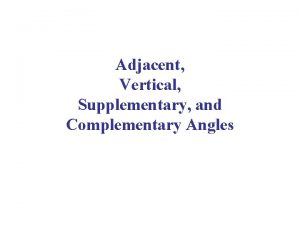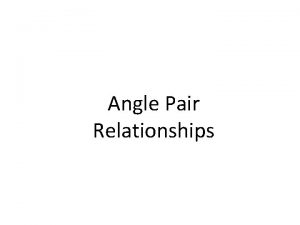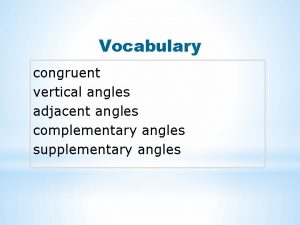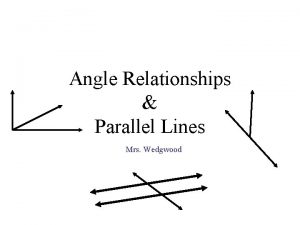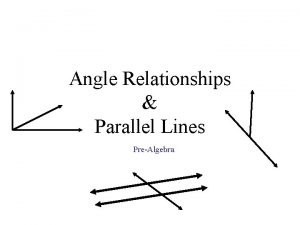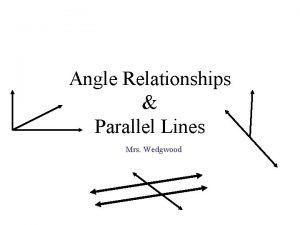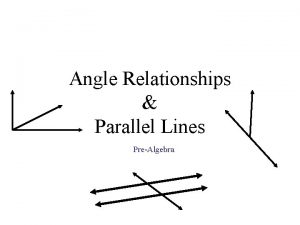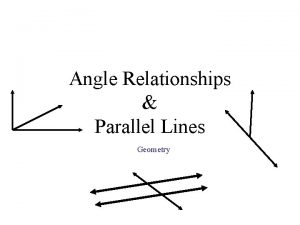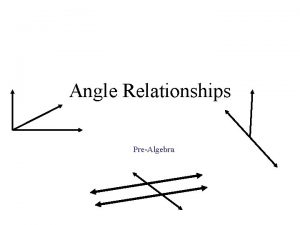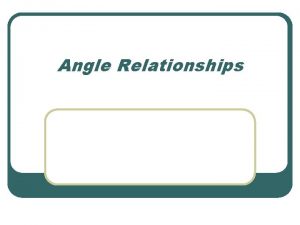1 5 Angle Pair Relationships Adjacent angles Two























- Slides: 23

1. 5 : Angle Pair Relationships

Adjacent angles: Two angles that share a common side and vertex 2 1 1 is adjacent to 2

Complementary Angles: Two angles that add to 90° 1 2 m 1 + m 2 = 90°

Supplementary Angles: Two angles that add to 180° 1 2 1 m 1 + m 2 = 180° 2

Linear Pair: Two adjacent angles whose noncommon sides are opposite rays (they form a line) 1 2 They will always add to 180° m 1 + m 2 = 180°

Vertical Angles: Two angles whose sides form two pairs of opposite rays 1 2 They will always be congruent!

1. Tell whether the indicated angles are adjacent. EFG and HGF no

1. Tell whether the indicated angles are adjacent. JNM and MNK yes

2. Name a pair of complementary angles, supplementary angles, and vertical angles. Vertical: ROL and NOP L M R N O Q P LOM and QOP Complementary: QOR and ROL MON and NOP Supplementary: ROL and LON ROM and MON QOL and LOM

2. Name a pair of complementary angles, supplementary angles, and vertical angles. Vertical: DGE and BGC A E EGB and DGC B D G C Complementary: DGE and EGA Supplementary: DGE and EGB DGA and AGB EGA and AGC

3. 1 and 2 are complementary angles. Given the measure of 1, find m 2. m 1 = 82° m 2 = 90 – 82 = 8°

3. 1 and 2 are complementary angles. Given the measure of 1, find m 2. m 1 = 23° m 2 = 90 – 23 = 67°

4. 1 and 2 are supplementary angles. Given the measure of 1, find m 2. m 1 = 82° m 2 = 180 – 82 = 98°

4. 1 and 2 are supplementary angles. Given the measure of 1, find m 2. m 1 = 105° m 2 = 180 – 105 = 75°

5. Find the measure of ABD and DBC. 4 x + 6 + 11 x – 6 = 180 15 x = 180 x = 12 m ABD = 4(12)+6 = 48+6 = 54° m DBC = 11(12)-6 = 132 -6 = 126°

5. Find the measure of ABD and DBC. 2 x + 3 x = 90 5 x = 90 x = 18 m ABD = 2(18) = 36° m DBC = 3(18) = 54°

6. Use the diagram below. Tell whether the angles are vertical angles, linear pair, or neither. 1 and 2 Linear pair

6. Use the diagram below. Tell whether the angles are vertical angles, linear pair, or neither. 1 and 3 Vertical angles

6. Use the diagram below. Tell whether the angles are vertical angles, linear pair, or neither. 2 and 4 Vertical angles

6. Use the diagram below. Tell whether the angles are vertical angles, linear pair, or neither. 5 and 7 neither

6. Use the diagram below. Tell whether the angles are vertical angles, linear pair, or neither. 5 and 8 neither

7. Find the values of x and y. 6 x – 11 + 2 x – 9 = 180 8 x – 20 = 180 8 x = 200 x = 25° 20 y + 19 + 2 x – 9 = 180 20 y + 19 + 2(25) – 9 = 180 20 y + 60 = 180 20 y = 120 y = 6°

7. Find the values of x and y. 21 x – 3 + 5 x + 1 = 180 26 x – 2 = 180 26 x = 182 x = 7° 4 y + 17 y – 9 = 180 21 y = 189 y = 9°
 Complementary supplementary vertical and adjacent angles
Complementary supplementary vertical and adjacent angles Exploring angle pairs
Exploring angle pairs Two vertical angles
Two vertical angles In the diagram gh bisects ∠fgi
In the diagram gh bisects ∠fgi Linear pair relationship
Linear pair relationship Pair relationship examples
Pair relationship examples Angle pair relationships
Angle pair relationships Which relationships describe the angle pair x° and 50º?
Which relationships describe the angle pair x° and 50º? Complementary linear pair vertical or adjacent
Complementary linear pair vertical or adjacent Angle klm and angle mln are a linear pair
Angle klm and angle mln are a linear pair Vertical angles
Vertical angles Are angle 3 and angle 6 vertical angles yes or no
Are angle 3 and angle 6 vertical angles yes or no Tell whether each angle is obtuse acute or right
Tell whether each angle is obtuse acute or right Non adjacent angles
Non adjacent angles Vertical angle theorem
Vertical angle theorem Line and angle
Line and angle Adjacent angles on parallel lines
Adjacent angles on parallel lines 4 x 180
4 x 180 Adjacent angles definition
Adjacent angles definition Trigonometry terminology
Trigonometry terminology Adjacent angles parallel lines
Adjacent angles parallel lines Straight angle
Straight angle Vertical angles find the value of x
Vertical angles find the value of x Complementary angles
Complementary angles
